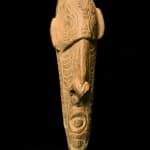Oceanic Middle Sepik River Savi Mask, 20th Century CE
Wood and Raffia
3.5 x 10.75 x 3.5
DE.031 (LSO)
Further images
This powerful mask was carved by one of the many tribes of the Sepik River region, Papua New Guinea. It is tall and comparatively narrow, with a shelf denoting the...
This powerful mask was carved by one of the many tribes of the Sepik River region, Papua New Guinea. It is tall and comparatively narrow, with a shelf denoting the brow and overshadowing the eyes, a long nose and a round mouth with the tongue protruding. The face is asymmetrical, the right brow slightly higher than the left. The surface is decorated with incised curvilinear abstract patterns arranged in bands and circles. Patination is light, with use wear on elevated areas.
The Sepik River is the largest and most important water system in Papua, and arises in the Central Highlands region. The tributaries and delta areas are fairly densely populated by numerous tribes, which have produced some astonishingly diverse artistic heritage. Art styles are based around villages – their heterogeneity is such that pieces can often be traced to their village of origin (and sometimes the sculptor). This piece is from the Middle Sepik area, although the village is currently unclear (perhaps Kamandimbit). Art is both ritual – designed to attract the positive attentions of spirits – and secular, especially including shields and weapons that are carved and painted in distinctive patterns. Masks such this were rarely worn – they were instead part of large superstructures (tumbuans) worn during dances in important ceremonies. There are various forms of mask, designed for diverse purposes. This piece is a Savi mask, powerful pieces with tongues protruding, gesturing defiance and aggression towards the village’s enemies.
This is an impressive piece of Oceanic art.
The Sepik River is the largest and most important water system in Papua, and arises in the Central Highlands region. The tributaries and delta areas are fairly densely populated by numerous tribes, which have produced some astonishingly diverse artistic heritage. Art styles are based around villages – their heterogeneity is such that pieces can often be traced to their village of origin (and sometimes the sculptor). This piece is from the Middle Sepik area, although the village is currently unclear (perhaps Kamandimbit). Art is both ritual – designed to attract the positive attentions of spirits – and secular, especially including shields and weapons that are carved and painted in distinctive patterns. Masks such this were rarely worn – they were instead part of large superstructures (tumbuans) worn during dances in important ceremonies. There are various forms of mask, designed for diverse purposes. This piece is a Savi mask, powerful pieces with tongues protruding, gesturing defiance and aggression towards the village’s enemies.
This is an impressive piece of Oceanic art.





